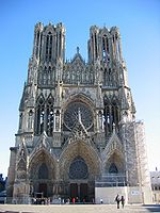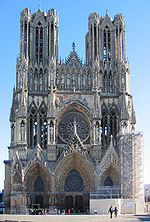
Perspective control
Encyclopedia


Perspective (graphical)
Perspective in the graphic arts, such as drawing, is an approximate representation, on a flat surface , of an image as it is seen by the eye...
. The control would:
- make all lines that are vertical in reality vertical in the image. This includes columns, vertical edges of walls and lampposts. Note that this is a commonly accepted distortion in constructed perspective; perspective is based on the notion that more distant objects are represented as smaller on the page; however, even though the top of the cathedral tower is in reality further from the viewer than base of the tower (due to the vertical distance), constructed perspective considers only the horizontal distance and considers the top and bottom to be the same distance away;
- make all parallel lines (such as four horizontal edges of a cubic room) cross in one point.
Perspective projection distortion
Perspective projection distortion
Perspective projection distortion is the inevitable misrepresentation of three-dimensional space when drawn or "projected" onto a two-dimensional surface....
occurs in photographs when the film plane is not parallel to lines that are required to be parallel in the photo. A common case is when a photo is taken of a tall building from ground level by tilting the camera backwards: the building appears to fall away from the camera.
Compare the two images to the right. The first suffers from perspective distortion — in the second that distortion has been corrected.
The popularity of amateur photography has made distorted photos made with cheap cameras so familiar that many people do not immediately realise the distortion. Keep in mind that this "distortion" is relative only to the accepted norm of constructed perspective (where vertical lines in reality do not converge in the constructed image), which in itself is distorted from a true perspective representation (where lines that are vertical in reality would begin to converge above and below the horizon as they become more distant from the viewer).
Perspective control at exposure

View camera
The view camera is a type of camera first developed in the era of the Daguerreotype and still in use today, though with many refinements. It comprises a flexible bellows which forms a light-tight seal between two adjustable standards, one of which holds a lens, and the other a viewfinder or a...
article.
Most large format
Large format
Large format refers to any imaging format of 4×5 inches or larger. Large format is larger than "medium format", the 6×6 cm or 6×9 cm size of Hasselblad, Rollei, Kowa, Pentax etc cameras , and much larger than the 24×36 mm frame of 35 mm format.The main advantage...
(4x5 and up) cameras have this feature, as well as plane of focus control built into the camera body in the form of flexible bellows and moveable front (lens) and rear (film holder) elements. Thus any focal length lens mounted on a view camera
View camera
The view camera is a type of camera first developed in the era of the Daguerreotype and still in use today, though with many refinements. It comprises a flexible bellows which forms a light-tight seal between two adjustable standards, one of which holds a lens, and the other a viewfinder or a...
or field camera
Field camera
A field camera is a view camera that can be folded in a compact size. Modern designs are little different from the first folding field cameras from the 19th century. In general they have more limited camera movements than the monorail cameras used in many professional studios worldwide.Modern field...
, and many press camera
Press camera
A press camera is a medium or large format camera suitable for use by press photographers.Press cameras were widely used from the 1900s through the early 1960s and commonly had the following features:* collapsibility into strong, compact boxes...
s can be used with perspective control.
Some interchangeable lens medium format, 35mm SLR
Single-lens reflex camera
A single-lens reflex camera is a camera that typically uses a semi-automatic moving mirror system that permits the photographer to see exactly what will be captured by the film or digital imaging system, as opposed to pre-SLR cameras where the view through the viewfinder could be significantly...
, and Digital SLR camera systems have PC, shift, or tilt/shift lens options which allow perspective control and, in the case of a tilt/shift lens, plane of focus control, but only at a specific focal length.
Perspective control in the darkroom
A darkroomDarkroom
A darkroom is a room that can be made completely dark to allow the processing of light sensitive photographic materials, including photographic film and photographic paper. Darkrooms have been created and used since the inception of photography in the early 19th century...
technician can correct perspective distortion in the printing process. It is usually done by exposing the paper at an angle to the film, with the paper raised toward the part of the image that is larger, therefore not allowing the light from the enlarger to spread as much as the other side of the exposure.
The process is known as rectification printing, and is done using a rectifying printer (transforming printer), which involves rotating the negative and/or easel. Restoring parallelism to verticals (for instance) is easily done by tilting one plane, but if the focal length of the enlarger is not suitably chosen, the resulting image will have vertical distortion (compression or stretching). For correct perspective correction, the proper focal length (specifically, angle of view) must be chosen so that the enlargement replicates the perspective of the camera.
Perspective control during digital post-processing
Digital post-processing software provides means to correct converging verticals and other distortions introduced at image capture.Adobe Photoshop
Adobe Photoshop
Adobe Photoshop is a graphics editing program developed and published by Adobe Systems Incorporated.Adobe's 2003 "Creative Suite" rebranding led to Adobe Photoshop 8's renaming to Adobe Photoshop CS. Thus, Adobe Photoshop CS5 is the 12th major release of Adobe Photoshop...
and GIMP
GIMP
GIMP is a free software raster graphics editor. It is primarily employed as an image retouching and editing tool and is freely available in versions tailored for most popular operating systems including Microsoft Windows, Apple Mac OS X, and Linux.In addition to detailed image retouching and...
have several "transform" options to achieve, with care, the desired control without any significant degradation in the overall image quality. Photoshop CS2 and subsequent releases includes perspective correction as part of its Lens Distortion Correction Filter; DxO Optics Pro from DxO Labs
DxO Labs
DxO Labs is a privately held image processing software company based in Boulogne-Billancourt, France.DxO Optics Pro is a personal computer package which corrects for various optical aberrations, notably image distortion, with corrections tuned to particular lenses and cameras. It also adjusts...
includes perspective correction; while GIMP (as of 2.6) does not include a specialized tool for correcting perspective, though a plug-in, EZ Perspective, is available. RawTherapee, a free and open-source raw converter, includes horizontal and vertical perspective correction tools too. Note that because the mathematics of projective transforms depends on the angle of view
Angle of view
In photography, angle of view describes the angular extent of a given scene that is imaged by a camera. It is used interchangeably with the more general term field of view....
, perspective tools require that the angle of view or 35 mm equivalent focal length
35 mm equivalent focal length
In photography, the 35 mm equivalent focal length is a measure that indicates the angle of view of a particular combination of a camera lens and film or sensor size...
be entered, though this can often be determined from Exif metadata.
It is commonly suggested to correct perspective using a general projective transformation tool, correcting vertical tilt (converging verticals) by stretching out the top; this is the "Distort Transform" in Photoshop, and the "perspective tool" in GIMP. However, this introduces vertical distortion – objects appear squat (vertically compressed, horizontally extended) – unless the vertical dimension is also stretched. This effect is minor for small angles, and can be corrected by hand, manually stretching the vertical dimension until the proportions look right, but is automatically done by specialized perspective transform tools.
An alternative interface, found in Photoshop (CS and subsequent releases) is the "perspective crop", which enables the user to perform perspective control with the cropping tool, setting each side of the crop to independently-determined angles, which can be more intuitive and direct.
Other software with mathematical models on how lenses and different types of optical distortions affect the image can correct this by being able to calculate the different characteristics of a lens and re-projecting the image in a number of ways (including non-rectilinear projections). An example of this kind of software is the panorama creation suite Hugin
Hugin (software)
Hugin is a cross-platform open source panorama photo stitching and HDR merging program developed by Pablo d'Angelo and others. It is a GUI front-end for Helmut Dersch's Panorama Tools and Andrew Mihal's Enblend and Enfuse...
.
However these techniques do not enable the recovery of lost spatial resolution in the more distant areas of the subject, or the recovery of lost depth of field
Depth of field
In optics, particularly as it relates to film and photography, depth of field is the distance between the nearest and farthest objects in a scene that appear acceptably sharp in an image...
due to the angle of the film/sensor plane to the subject. These transforms involve interpolation
Interpolation
In the mathematical field of numerical analysis, interpolation is a method of constructing new data points within the range of a discrete set of known data points....
, as in image scaling
Image scaling
In computer graphics, image scaling is the process of resizing a digital image. Scaling is a non-trivial process that involves a trade-off between efficiency, smoothness and sharpness. As the size of an image is increased, so the pixels which comprise the image become increasingly visible, making...
, which degrades the image quality, in particular blurring high-frequency detail. How significant this is depends on the original image resolution, degree of manipulation, print/display size, and viewing distance, and perspective correction must be traded off against preserving high-frequency detail.
Perspective control in virtual environments
Architectural images are commonly "renderedRendering (computer graphics)
Rendering is the process of generating an image from a model , by means of computer programs. A scene file contains objects in a strictly defined language or data structure; it would contain geometry, viewpoint, texture, lighting, and shading information as a description of the virtual scene...
" from 3D computer models, for use in promotional material. These have virtual cameras within to create the images, which normally have modifiers capable of correcting (or distorting) the perspective to the artist's taste. See 3D projection
3D projection
3D projection is any method of mapping three-dimensional points to a two-dimensional plane. As most current methods for displaying graphical data are based on planar two-dimensional media, the use of this type of projection is widespread, especially in computer graphics, engineering and drafting.-...
for details.

